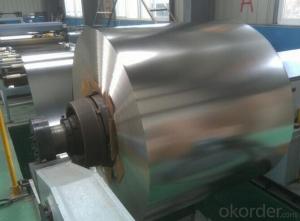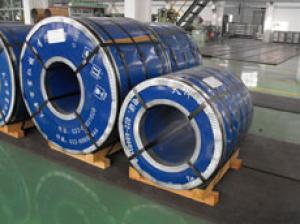Electrolytic Tinplate Sheets for 0.31 Thickness MR Sheets
- Loading Port:
- Tianjin
- Payment Terms:
- TT or LC
- Min Order Qty:
- 25 m.t.
- Supply Capability:
- 8000 m.t./month
OKorder Service Pledge
OKorder Financial Service
You Might Also Like
1.Structure of Electrolytic Tinplate Sheets for 0.31 Thickness MR Sheets Description
Electrolytic Tinplate Sheets is one of the metal packing materials, which is widely used for making painting cans ,chemical package cans , electrical cable ,battery and metal printing etc.
2. Main Features of Electrolytic Tinplate Sheets for 0.31 Thickness MR Sheets
Steady and high quality
Fast shipment
Good experience for export work
For the surface, Plate uniform in thickness,uniform and smooth tin coating, without flaws,rusts,scratch,wave,nick of tin coating etc.
Price competitive
3.Electrolytic Tinplate Sheets for 0.31 Thickness MR Sheets Images

4. Electrolytic Tinplate Sheets for 0.31 Thickness MR Sheets Specification
Standard : GB2520-2000 ,JIS G3303
Steel type : SPCC
Coating : 2.8/2.8
Surface: Bright, Stone ,
Thickness:0.31
Width :600MM~1000MM
Temper : T1~T5
Package: tinplate wrapped completely with an inner cover of plastic or waterproof papers with vorners protected with metal angels.
5.FAQ of Electrolytic Tinplate Sheets for 0.31 Thickness MR Sheets
A. What is the package of tinplate? (Referred as below)
For sheets, thin plastic film + rust-proof paper + metallic cover + metallic angles+ steel band strips + fumigated wooden pallet.
For coil, thin plastic film + rust proof paper + metallic cover + steel band strips + fumigated wooden pallet
B. The surface of tinplate could you supply?
Stone finish, Bright finish, Matte finish, Silver finish
C. What quantity is the minimum order of tinplate?
Usually, the minimum quantity is 25MT. For special case, consult with us.
D. Can it make to be BA or CA for annealing?
Yes, both can do with.
- Q: What are the main factors influencing the price of tinplate?
- The main factors influencing the price of tinplate include the cost of raw materials, particularly tin and steel, as well as supply and demand dynamics in the market. Other factors such as production and manufacturing costs, fluctuations in currency exchange rates, and global economic conditions can also impact tinplate prices. Additionally, government policies and regulations related to trade, tariffs, and environmental standards can influence the price of tinplate.
- Q: Tin plated tin plated?
- Can electroplate.If the parts need tin plating, it is better not to use tinplate (tin plated steel / strip), galvanized steel plate / ordinary steel plate / strip with or without plating.
- Q: What are the different thickness options for tinplate?
- The different thickness options for tinplate typically range from 0.13mm to 0.5mm.
- Q: How is tinplate affected by different types of sauces and condiments?
- Tinplate is generally resistant to most sauces and condiments due to its protective coating. However, highly acidic or salty sauces may cause corrosion over time, compromising the tinplate's integrity. It is advisable to promptly clean any spills or residues to minimize potential damage.
- Q: Why tinned fruit cans, some snow wall, and some inner wall does not appear?
- Tin cans inside must use the high Xiliang (11.2 - 15.1), the inner wall of the conventional oxidation after a snowflake, which belongs to the benign chemical reaction, enhance the taste.
- Q: What are the main factors affecting tinplate coil loading and unloading?
- The main factors affecting tinplate coil loading and unloading include the size and weight of the coils, the type and condition of the loading and unloading equipment, the skill and experience of the operators, and the safety precautions in place. Additionally, factors such as the layout of the loading and unloading area, weather conditions, and any specific requirements or regulations for handling tinplate coils may also impact the process.
- Q: What are the potential health risks associated with tinplate?
- The potential health risks associated with tinplate are primarily due to the possibility of tin and other metals leaching into food or beverages stored in tinplate containers. Some studies suggest that high levels of tin exposure may lead to stomach and intestinal issues, such as nausea, vomiting, and diarrhea. However, the overall health risks are considered low, as strict regulations and safety measures are in place to minimize these concerns.
- Q: Can tinplate be used for military applications?
- Yes, tinplate can be used for military applications. It is a versatile material that offers several benefits such as corrosion resistance, durability, and ease of fabrication. Tinplate can be used for various military applications including ammunition packaging, shelter construction, and equipment protection.
- Q: What are the different ways to recycle tinplate packaging?
- There are several different ways to recycle tinplate packaging. One common method is to separate the tinplate from other materials, such as paper or plastic, and then send it to a recycling facility where it can be melted down and reused to make new tinplate products. Another option is to reuse the tinplate packaging for storage or other purposes before eventually recycling it. Additionally, some municipalities offer curbside recycling programs where tinplate packaging can be collected and processed along with other recyclable materials.
- Q: How does tinplate affect the overall branding of products?
- Tinplate can significantly impact the overall branding of products as it offers various advantages. Its sleek and glossy appearance adds a premium and sophisticated touch to the packaging, enhancing the perceived value of the product. Additionally, tinplate provides excellent protection against moisture, light, and oxygen, ensuring the quality and freshness of the contents. This durability and protective feature associated with tinplate packaging help to build trust and credibility among consumers, reinforcing the brand image. Furthermore, tinplate's versatility allows for unique and eye-catching designs, facilitating differentiation and attracting consumers' attention on store shelves. Overall, tinplate plays a crucial role in elevating the branding of products, creating a memorable and positive consumer experience.
Send your message to us
Electrolytic Tinplate Sheets for 0.31 Thickness MR Sheets
- Loading Port:
- Tianjin
- Payment Terms:
- TT or LC
- Min Order Qty:
- 25 m.t.
- Supply Capability:
- 8000 m.t./month
OKorder Service Pledge
OKorder Financial Service
Similar products
Hot products
Hot Searches
Related keywords



























